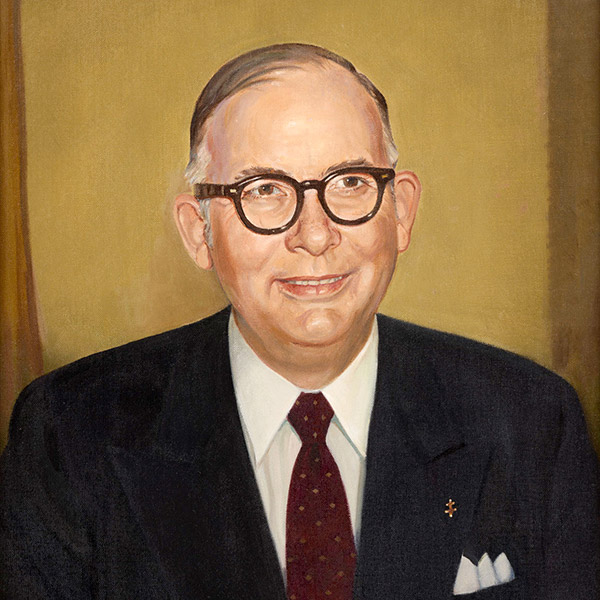William R. White
Baylor President, 1948-1961

In selecting a new president, the trustees recognized that the University needed someone who had the ability to salve the professional worries of the faculty and staff over the future of the institution -- fiscally and physically. Many men were recommended and several of these were considered by the board, but the only individual upon whom all the trustees could agree was "Billy" White, pastor of the First Baptist Church of Austin, Texas.
Losing both his parents by eight years of age, William R. White was raised by his grandmother in Frankston. Though frail and thin he had an unusual gift of concentration, a unique ability for retention and a powerful voice that he used frequently on the stage in amateur productions at Rusk Academy where he received his preparatory training. As he grew up he became active in church life and eventually decided to become a minister, being ordained three weeks prior to his eighteenth birthday.
He entered Baylor in 1913 but soon transferred to Howard Payne College in Brownwood where the climate was more conducive to the improvement of his health. Graduating in 1917, White enrolled at Southwestern Baptist Theological Seminary where he received the doctorate in 1924 and then remained to teach missions for the next three years.
White left to pastor the First Baptist Church at Greenville and then pastored the First Baptist Church of Lubbock. He next served as executive secretary of the Baptist General Convention of Texas, which was followed by pastorates at Broadway Baptist Church, Fort Worth, and the First Baptist Church of Oklahoma City which he resigned in 1940 to become president of Hardin-Simmons University. He left that position to become editorial secretary of the Baptist Sunday School Board in Nashville and then returned to the First Baptist Church of Austin from which the Baylor trustees beckoned him for service.
At his inauguration on April 13, 1948, White announced his desire to renew the religious emphases of the institution and to build additional facilities to enhance the school's physical plant. To the packed Waco Hall audience he said "Those who launched Baylor University had a definite concept of its two-fold purpose. It was to serve the church and the state. I shall add what they always implied -- the world. By the church they meant the body of Christ as an institution. They meant for Baylor to provide lay and ministerial leadership for our Baptist churches. They intended to influence culture and society with our great distinctive principles. They wanted to enrich and enforce the kingdom of God through Christian education." He then added that Baylor must lead in keeping active these great distinctives. White further emphasized Baylor "is committed to the great principles of the American way of life and we want to see those principles preserved and given a larger application to every phase of life."
Within a year enrollment on the Waco campus passed the 5,000 mark (5,102) with a few hundred more in the programs which were being offered in Dallas and Houston. Additional facilities, both temporary and permanent were constantly on the drawing board and rising from the ground. The Union Building was soon completed, the football stadium was constructed, and plans for the Tidwell Bible Building and the Browning Library began to take final shape.
Over the next few years White concentrated on facilities, student recruitment, and fund-raising. He was quite successful in all these endeavors and in the fall of 1954 he reported that enrollment was still near the 6,000 mark and many improvements to the campus were underway.
During the next two years construction highlights punctuated all University reports as Martin Hall, Allen Hall, Tidwell Bible Building, Morrison Constitution Hall, Speight-Jenkins apartments, Roxy Grove Hall, and Ruth Collins Hall were completed. At the end of this period it was reported that endowment had grown from the $3.3 million when White became president to $10.8 million and the University's assets, including the Waco, Dallas and Houston facilities, had increased from $17.1 million to $32.3 million.
In 1958, even though enrollment was dropping slightly, White announced new construction plans that included the business school building, a new science building, another men's dormitory, the expansion of the bookstore and the renovation of several smaller facilities. Urban renewal proposals to remove the poor housing areas northeast of the campus also began to be discussed, and in 1959 with the creation of the Baylor-Waco Foundation, the University embarked on the first step of what would become a highly successful campus expansion and enhancement program.
In 1959, feeling that his talents could better be used in development and public relations functions rather than as an administrator, White worked with the trustees to change his responsibilities so that he would be allowed to travel and represent the University in these roles. To do so, the trustees made School of Law Dean Abner V. McCall executive vice president with authority to oversee the administration of the University. This arrangement continued until 1961 when McCall became president of the University and White was named chancellor.
